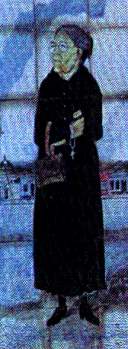Did You Know…?
A charwoman-actress once captivated Mexican high society in her alter ego as Don Carlos Balmori.
An elaborate tomb in Mexico City’s main cemetery, the Panteón Civil de Dolores, is a lasting reminder of one of the nation’s strangest ever spoofs. Hand-painted tiles once decorated the tomb depicting Concepción (Conchita) Jurado as both an elderly grey-haired woman, and also as a swanky Spanish businessman, Don Carlos Balmori. Other tiles showed some of the deceptions she carried out. Sadly, some of the tiles have now disappeared.

Those taken in by her masterful and audacious feats of male impersonation held annual reunions at her gravesite for many years following her death in 1931. In the words of a 1945 issue of Time Magazine, the mourners constituted a “society of her worshipful dupes”. Now, the grave, and Conchita’s exploits are largely forgotten.
Conchita Jurado was born in 1865, and little is known about her early life. Was she really always a charwoman, with aspirations of being an actress, or was she, as some sources claim, really a working actress? Over the years, she perfected her party piece, which was to assume the appearance, language and behavior of an unbelievably wealthy Spanish gentleman.
In 1926, now in her 60s and egged on by her friends, this alter ego ventured out into high society as Spanish gentleman Don Carlos Balmori, complete with “overcoat, slouch felt hat, a false-diamond stickpin and a false black mustache.” 1
Rumors quickly swirled around Balmori. He was rich, immensely rich. He had a theater named after him. He was connected, very well connected, to the highest ranks of nobility. Giddy with desire, numerous women fell in love with this eccentric Spanish “millionaire”, who was also courted by politicians and society grandees.
With the support of at least one newspaper editor, Balmori’s “financial coups, big-game hunting exploits and amorous adventures around the world were regularly reported, complete with pictures, in the Mexican Press.” 2
Balmori’s amazing wealth allowed him to be distastefully blunt and rude about all manner of things. He was able to enjoy high society life while perpetrating dozens of elaborate hoaxes, some funny, others positively cruel, over the next five years. He died, when Conchita passed away, in 1931.
How were the hoaxes carried out? Balmori developed the knack of promising people exactly what they most wanted, and then backing his promises up with fat checks. In most cases, the recipient was required to undergo some kind of humiliation before financial support was provided. Acceptance of the humiliation revealed their overriding ambition or lack of dignity. Later, when the check turned out to be worthless, the hapless mark was sworn to secrecy and admitted to the exclusive club of the duped, whose members helped plan the next deception.

The club included bankers, generals, musicians, and at least one ex-President. New victims, those chosen to be introduced to Balmori at the next carefully-staged party, were known as nuevos puerquitos (new little pigs). Don Carlos’s entourage included his “private secretary”, Luis Cervantes Morales, who later penned a book about the exploits of his master.
During five action-packed years, so many hoaxes were carried out that they even inspired a new colloquialism (not yet found in the Spanish dictionary): balmoreada – the kind of social gathering where a Balmori-like joke is played out.
One of the funniest balmoreadas must have been when Don Carlos held a soiree for friends and asked the top detective of the day, Valente Quintana, to attend because he feared that someone there was actually an imposter. The detective assured the host that he was confident he would spot, and unmask, the trouble-maker before any mischief took place.
After applying all his tricks of the trade on the guests, he was forced to admit defeat, at which point Don Carlos revealed himself as Conchita, saying, as she always did in the denouement, “Nothing is exactly as it seems to be. Nothing is real. The truth is always hidden.” 2 Despite his damaged pride, the detective saw the funny side, and subsequently joined the “Balmoris” in enthusiastically planning further adventures.
Conchita’s refrain, that nothing is ever exactly as it seems to be, is surely one of the most apt one-liners of all time – perfectly appropriate to so many aspects of life in Mexico.
This article is the basis for Chapter 23 in the author’s Mexican Kaleidoscope: myths, mysteries and mystique (Sombrero Books, 2016).
Sources
- 1 Anon. Society of Dupes in Time Magazine, Dec. 10, 1945.
- Australia, Gerardo. El cenit del Servicio Secreto. Reforma Oct. 19, 2004.
- 2 Cottrell, John. The Great Cities: Mexico City. Time Life International. 1979.
- García Bergua, Ana. Balmoreados in La Jornada Semanal, núm. 560, Nov. 27, 2005.
Text © Copyright 2007 by Tony Burton. All rights reserved.
